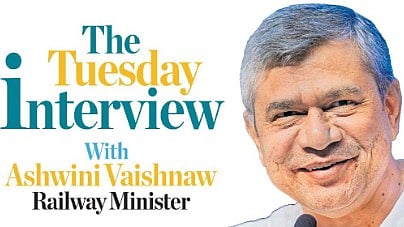
The Narendra Modi government has faced sharp criticism from the Opposition following a series of train accidents. In an interview with DH, Railway Minister Ashwini Vaishnaw discussed the safety measures being implemented by the Indian Railways. He tells Ajith Athrady that the ministry plans to spend over Rs 1.08 lakh crore this year to enhance safety Excerpts:
The government is under attack from the Opposition parties due to the spate of railway accidents.
Safety is our government’s top priority. Whenever an accident occurs, we have made it a point to go to the root cause. We implement systemic changes wherever necessary, improve procedures where required, and change technology wherever needed.
Apart from this, the Railways has undertaken massive safety measures across its network, including rigorous quality checks for tracks and signals. So far, we have completed 97,000 inspections and verified 90,000 signal plans. More than 2,500 km of tracks have been renewed. Ultrasound testing is being conducted for the entire railway network. This fiscal alone, 1,86,000 km of tracks have been checked using ultrasound machines. The Railways will spend Rs 1.08 lakh crore on safety in 2024–25. As part of the safety measures, the Railways constructed more railway over bridges, foot over bridges, and railway underpasses.
What is the status of the rollout of the automatic train protection system, Kavach?
Since the National Democratic Alliance (NDA) government came to power in 2014, it has prioritised Kavach. The Congress-ruled government could not do it in 58 years; the BJP did it in just 10 years. Indian Railways’ anti-collision device system introduced in 2006 was declared failed in 2012. The automatic train protection system was not implemented on even one km of Indian Railways till 2014. However, we got the new technology developed, tested, and started the deployment. The first field trials of Kavach on passenger trains began in February 2016, and, based on the experience and independent safety assessment of the system by a third party, three firms were approved in 2018-19 for the supply of Kavach.
What are the timelines for implementing Kavach across the network?
The Prime Minister has set an aggressive target. We would like to cover the entire railway network within 5–6 years. Work is underway to operationalise the system on the 3,000-km Mumbai-Delhi and Delhi-Kolkata routes, and the installation work on another 6,000 km will be started soon. Version 4 of Kavach was approved on July 16. The government has floated tenders for fitting 10,000 locomotives and 9,600 km of track length with Kavach. While new trains in the future may come fitted with the Kavach system, it needs to be installed on the existing locomotives. The first section with Kavach 4.0 got commissioned between Kota and Sawai Madhopur.
I reviewed a trial of the Kavach system between Sawai Madhopur and Indargarh stations in the West Central Railway zone last week. I travelled in the engine of a Kavach-fitted train, which, while speeding at 130 kilometres per hour, stopped 50 meters before a red signal on its own without any manual interference with the braking function by the loco pilot. Kavach was tested for seven different emergency situations, and it worked as expected in all of them.
Vande Bharat has been launched on several routes. Opposition parties say the government is doing nothing for the common man who can’t afford to travel on air-conditioned superfast trains.
The government focuses on improving the travel experience of lower-income and middle-income groups. We are adding general coaches that cater to lower-income groups. A total of 108 trains have been augmented with new general coaches, and 12,500 new general coaches are being manufactured.
The NaMo Bharat Rapid Rail service, which was flagged off between Ahmedabad and Bhuj recently, is going to be revolutionary because, at a very low cost, a very high-quality service will be provided to inter-city commuters.
We have already introduced non-AC Amrit Bharat trains comprising general and sleeper coaches with better facilities.
There were reports that miscreants are trying to derail trains by placing objects on tracks.
The railway administration is on alert and taking this matter seriously. We are constantly in touch with all state governments. State DGPs, Home Secretaries, and the National Investigating Agency are also involved. Strict action will be taken against anyone trying to cause any accident. This is our commitment. The railway administration is working hard to ensure that no such incidents occur. The railways also decided to install multiple cameras on all trains to keep a watch on tracks and surroundings.
What is the status of the bullet project between Mumbai and Ahmedabad?
The construction work on the Ahmedabad-Mumbai high-speed bullet train project is in full swing, and viaduct pillar work on a 320-km stretch has been completed.
The government aims to operationalise the bullet train’s first phase between Surat and Bilimora in South Gujarat by 2026. The full stretch is expected to be completed in 2028.
